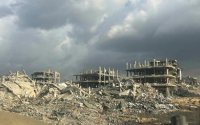18 January 2007The Independent
Climate change stands alongside the use of nuclear weapons as one of the greatest threats posed to the future of the world, the Cambridge cosmologist Stephen Hawking has said.
Professor Hawking said that we stand on the precipice of a second nuclear age and a period of exceptional climate change, both of which could destroy the planet as we know it.
He was speaking at the Royal Society in London yesterday at a conference organised by the Bulletin of Atomic Scientists which has decided to move the minute hand of its "Doomsday Clock" forward to five minutes to midnight to reflect the increased dangers faced by the world.
Scientists devised the clock in 1947 as a way of expressing to the public the risk of nuclear conflagration following the use of the atomic weapons that destroyed Hiroshima and Nagasaki at the end of the Second World War.
"As we stand at the brink of a second nuclear age and a period of unprecedented climate change, scientists have a special responsibility, once again, to inform the public and to advise leaders about the perils that humanity faces," Professor Hawking said. "As scientists, we understand the dangers of nuclear weapons and their devastating effects, and we are learning how human activities and technologies are affecting climate systems in ways that may forever change life on Earth.
"As citizens of the world, we have a duty to share that knowledge. We have a duty, as well, to alert the public to the unnecessary risks that we live with every day, and to the perils we foresee if governments and societies do not take action now to render nuclear weapons obsolete and to prevent further climate change.
"We are here today to outline the results of the Bulletin's recent deliberations and to warn the public about the deteriorating state of world and planetary affairs by moving the hand of the clock," Professor Hawking said.
"Lord Rees of Ludlow, president of the Royal Society, said humankind's collective impacts on the biosphere, climate and oceans were unprecedented. These environmentally-driven threats 'threats without enemies' should loom as large in the political perspective as did the East-West political divide during the Cold War era.
Technology in the 21st century could offer immense opportunities to everyone but it would also present new threats that were more diverse and more intractable than those posed by nuclear weapons, Lord Rees said.
"To confront these threats successfully and to avoid foreclosing humanity's long-term potential scientists need to channel their efforts wisely and engage with the political process nationally and internationally.
"We shall need, in all fields of science, individuals with the wisdom and commitment of the atomic scientists who founded the Bulletin," he said.
The board of directors of the Bulletin of the Atomic Scientists said the threat of nuclear apocalypse was now almost matched by the environmental threats posed by climate change.
"We stand at the brink of a second nuclear age. Not since the first atomic bombs were dropped on Hiroshima and Nagasaki has the world faced such perilous choices," the board said in a statement issued yesterday.
"North Korea's recent test of a nuclear weapon, Iran's nuclear ambitions, a renewed US emphasis on the military utility of nuclear weapons, the failure to adequately secure nuclear materials and the continued presence of some 26,000 nuclear weapons in the United States and Russia are symptomatic of a larger failure to solve the problems posed by the most destructive technology on Earth.
"As in past deliberations, we have examined other human-made threats to civilisation. We have concluded the dangers posed by climate change are nearly as dire as those posed by nuclear weapons. The effects may be less dramatic in the short term than the destruction that could be wrought by nuclear explosions, but over the next three to four decades climate change could cause drastic harm."






